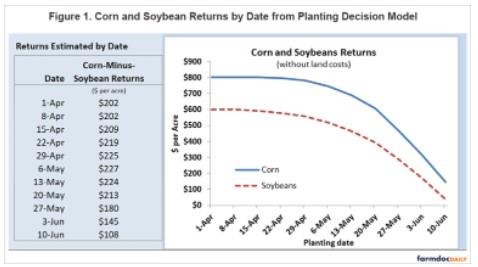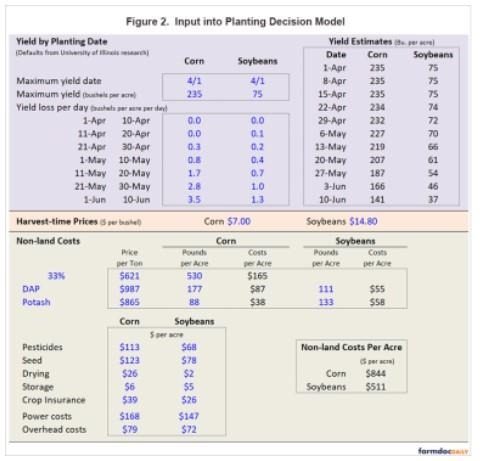Figure 1 comes directly from the Planting Decision Model and shows estimated returns from corn and soybeans planted on differing dates. The graph shows corn returns (blue, solid line) and soybean returns (red, dashed line) by date. As can be seen, corn is projected to be more profitable than soybeans on any date. Margins are large in April. For example, corn planting has a $225 per acre advantage on April 29 (see the table in Figure 1 giving corn-minus-soybean returns by date). Corn-minus-soybean returns are $228 per acre on May 6, declining to $108 per acre on June 10.

The assumptions in return calculations are shown in more detail in Figure 2. Yields are for central Illinois farmland of high productivity. Maximum yields are set at 235 bushels per acre for corn and 75 bushels per acre for soybeans. Yield losses per day are taken from Table 1 of an April 14, 2022, farmdoc Daily written by Scott Irwin summarizing yield trial information conducted by Emerson Nafziger. Given these inputs, corn yields are projected at 235 bushels per acre through April 15, declining to 141 bushels per acre by June 10. Soybean yields are projected at 75 bushels per acre through April 15, then dropping to 37 bushels per acre by June 10.

Prices used to make projections are $7.00 per bushel for corn and $14.80 per bushel for soybeans. These are mid-April 2021 cash bids for fall delivery in Illinois.
Fertilizer prices are $621 per ton for 32% nitrogen solution, $987 per ton for DAP, and $865 per bushel for potash. Prices are taken from the April 7, 2022 edition of the Illinois Production Cost Report, a U.S. Department of Agriculture publication. These prices are high from a historical standpoint (farmdoc daily, October 26, 2021). A nitrogen solution is used in the analysis as most farmers likely would be using this source given the later date in the planning session. DAP and potash are applied at replacement rates, implying that nutrients used by the 2022 crop must be replaced in the future at current prices.
The 2022 Crop Budgets published on April 12, 2022 (farmdoc daily) are used for the remainder of the costs: pesticides, seed, drying, storage, crop insurance, power, and overhead costs.
Note that the planting decision model does not include crop insurance in its calculations. Planting after the final plant date for crop insurance purposes will result in reduced insurance guarantees. Moreover, taking a prevent plant crop insurance payment becomes an option. Final plant dates for corn are June 5 for most of Illinois and May 31 for southern Illinois. Final plant dates for soybeans are June 15 for northern Illinois and June 20 for southern Illinois (see maps in farmdoc daily, April 11, 2017).
Commentary
- Unlike many years, corn is projected to be more profitable than soybeans on all planting dates from April 1 to June 10. In many years, soybeans become more profitable than corn later in the planting season.
- Yield and profit declines do not become large until May arrives. In Illinois, there is still time for much of 2022 planting to occur in relatively optimal conditions from an expected yield and expected profit standpoint. Obviously, the weather will play a role in whether planting occurs in an optimal setting.
- Corn is projected to be more profitable than soybeans, as has been the case in our three revisions of 2022 Crop Budgets (see farmdoc daily, April 12, 2022). The switch to soybeans from corn signaled in the Planting Intentions Report released on March 31 caused prices to swing even more in favor of corn.
- Some farmers may still be considering a switch from soybeans to corn for the 2022 crop. If this is considered, pricing some of the corn seems prudent as considerable price uncertainty exists moving forward. Note that the above budgets are for corn-after-soybeans. If farmland was corn last year, then additional costs may occur that should be included in the budget analysis.
- Input supply and price uncertainty related to nitrogen fertilizer are likely contributing factors to farmers switching from corn to soybeans in 2022. While nitrogen fertilizers and all agricultural inputs are largely in place for the 2022 crop, fertilizer supply and availability likely will be a concern moving into fall, potentially impacting 2023 planting decisions. The agricultural industry may wish to work on ways to reduce input uncertainties moving into the 2023 crop.
Source : illinois.edu